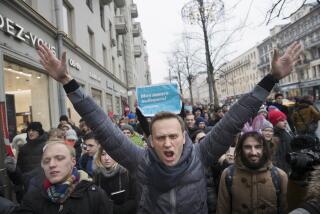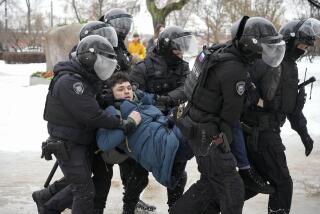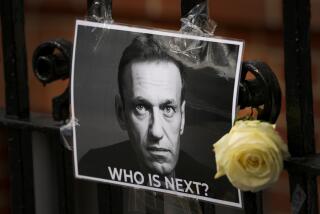Soviets Revive Old Strong-Arm Methods to Clamp Down on Protesters
MOSCOW — Alexander Kholmiansky, a 37-year-old computer engineer and Jewish activist, left his apartment recently to join about 50 others in a demonstration against anti-Semitism.
He was barely out the door when three men approached him, flashed their bright red KGB security police identification cards and forced him into a car.
Kholmiansky was taken to an opornypunkt , a small police station, and held for three hours until well after the scheduled time for the public protest.
“If you continue to make trouble, you’ll face trouble . . . ,” he quoted a KGB agent as warning him.
Other would-be demonstrators never left their homes because KGB officers arrived and kept them there under a version of house arrest. Thirty people who managed to get close to the protest site were picked up by police and detained for hours.
The protest never came off because the KGB has reverted to its own kind of “preventive detention” to bottle up demonstrators.
In recent months, Soviet officials have revived the use of once-familiar tactics against dissidents to crack down on demonstrations following a brief loosening of controls.
“The lid is on again,” Kholmiansky said in an interview.
Western television news crews who try to cover demonstrations have been roughed up by tough-looking men who operate with police blessing as they damage cameras and wrestle photographers to the ground.
CBS and NBC bureau chiefs in Moscow recently complained to a Soviet Foreign Ministry spokesman that camera crews and valuable equipment are endangered by the assaults.
The KGB came under especially heavy criticism in the West last February, when it deployed scores of men to break up a protest by a handful of demonstrators seeking the release from prison of Jewish activist Josef Begun.
The demonstrators, including Begun’s son, Boris, were manhandled and Western journalists were roughed up during the confrontation, which stretched out over several days and became known as “the battle of Arbat.” (The Arbat is a square near the city center and the frequent site for gatherings here.) Western critics asked how Soviet leader Mikhail S. Gorbachev’s policy of openness could be reconciled with the strong-arm methods used on the Arbat.
Relenting, Soviet officials released Begun from prison, and the success of that protest encouraged other groups to press their cause. The Battle of Arbat thus became a symbol of a more tolerant policy toward dissenters.
Last July, in an extraordinary display of tolerance, police allowed Crimean Tatars to camp overnight outside the Kremlin Wall, just a stone’s throw from Red Square.
The Tatars, who were seeking restoration of their homeland after Josef Stalin’s decision to exile the entire nationality during World War II, later were moved to a park far from the city’s center. But the protest continued.
Shortly afterward, however, the Moscow City Council imposed new regulations forbidding demonstrations without a permit and ruling large sections of the central city off-limits for such events.
The area around the Kremlin, the Communist Party Central Committee offices and such well-known protest sites as the Arbat were placed in the prohibited zone.
Police soon began to show up in force within minutes of a public protest, roughly shoving the participants into waiting buses and whisking them away from the scene. This happened to a group of Hare Krishna believers, for example, who tried to make their case for official recognition of their sect in front of Moscow’s City Hall.
Correspondents showing up for unofficial press conferences have been refused admission to buildings where they were to take place.
The usual police explanation: “Measures have been taken.” Under Soviet law, police can detain anyone for three hours to establish their identity. In addition, the Western concept of habeas corpus, a barrier against arbitrary detentions, is not followed here.
More to Read
Sign up for Essential California
The most important California stories and recommendations in your inbox every morning.
You may occasionally receive promotional content from the Los Angeles Times.










